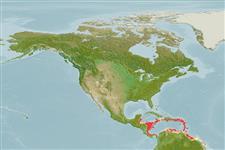Environment: milieu / climate zone / depth range / distribution range
Ecologie
marien rifbewoner; diepte 0 - 66 m (Ref. 9710). Subtropical; 19°N - 1°S, 89°W - 48°W (Ref. 55171)
Western Atlantic: Bermuda, Florida Keys (USA), Gulf of Mexico, Bahamas; Greater Antilles (including Cuba, Hispanola, Puerto Rico, Jamaica and Cayman Is.), Virgin Is.; Lesser Antilles (island chain south of the British Virgin Islands to Grenada); western Caribbean (ne tip of the Yucatan Peninsula to Colombia, including offshore islands; northern South America (region north of Amazon River including Trinidad and Tobago and off coasts of Colombia, Venezuela. Eastern Atlantic: Ascension Island.
Grootte / Gewicht / Leeftijd
Maturity: Lm ? range ? - ? cm
Max length : 20.0 cm TL mannelijk / geslacht onbekend; (Ref. 7251)
Korte beschrijving
Determinatiesleutels | Morfologie | Morfometrie
Dorsale zachte stralen (totaal) : 11 - 12; Anale zachte stralen: 6 - 7. Illicium about twice as long as second dorsal spine (Ref. 26938).
Inhabit shallow reefs (Ref. 9710). Commonly found in areas with sponges; background hue of the fish conforms to that of the dominant sponge in the areas and the ocelli look like openings in the sponge. Feed mainly on fishes, but also eat crustaceans (Ref. 13442). A voracious predator, with many color phases used for camouflage. Oviparous (Ref. 205). Eggs are bound in ribbon-like sheath or mass of gelatinous mucus called 'egg raft' or 'veil' (Ref. 6773). Most common frogfish in the West Indies (Ref. 26938).
Levenscyclus en paargedrag
Maturiteit | Voortplanting | Paaien | Eieren | Fecunditeit | Larven
Oviparous.
Robins, C.R. and G.C. Ray, 1986. A field guide to Atlantic coast fishes of North America. Houghton Mifflin Company, Boston, U.S.A. 354 p. (Ref. 7251)
Status op de Rode Lijst van het IUCN (Ref. 130435: Version 2024-2)
Gevaar voor de mens
Harmless
Gebruik door de mens
Visserij: visserij voor eigen gebruik; Aquarium: Commercieel
Tools
Speciale rapporten
Download XML
Internetbronnen
Estimates based on models
Preferred temperature (Ref.
123201): 27.1 - 28.3, mean 27.8 °C (based on 78 cells).
Fylogenetische diversiteitsindex (Ref.
82804): PD
50 = 0.5005 [Uniqueness, from 0.5 = low to 2.0 = high].
Bayesian length-weight: a=0.02630 (0.01029 - 0.06725), b=2.96 (2.73 - 3.19), in cm total length, based on LWR estimates for this (Sub)family-body shape (Ref.
93245).
Trofisch niveau (Ref.
69278): 4.3 ±0.7 se; based on diet studies.
Weerstandsvermogen (Ref.
120179): Hoog, minimale populatieverdubbelingstijd minder dan 15 maanden (Fec assumed to be > 10,000).
Fishing Vulnerability (Ref.
59153): Low vulnerability (10 of 100).
Nutrients (Ref.
124155): Calcium = 33.2 [14.6, 80.1] mg/100g; Iron = 0.619 [0.309, 1.196] mg/100g; Protein = 19.5 [17.0, 22.7] %; Omega3 = 0.182 [0.066, 0.484] g/100g; Selenium = 12.3 [4.9, 32.9] μg/100g; VitaminA = 114 [27, 508] μg/100g; Zinc = 0.686 [0.399, 1.116] mg/100g (wet weight);
